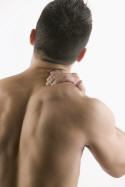|

Acute and chronic pain syndromes, as some of society s most costly health problems, have an enormous impact on individual,
national, and global levels. In the United States, chronic pain is the third most common health-care problem, behind heart
disease and cancer, with the combined annual costs of lost work days, doctor visits, hospital stays, pain-reducing drugs,
and disability totaling an estimated $100 billion.
Long lasting pain often creates a chronic pain cycle: Pain, lack of exercise, limited physical activity, chronic fatigue,
stress, depression, muscle tension, tightness, cramping, sensitive nerves, and again, pain. Patients suffer from this pain
cycle. Some patients even feel that their quality of life changes completely due to a chronic pain condition.
According to Traditional Chinese Medicine (TCM), nothing in the human body can function independently. Pain is the bodys
warning alarm. It tells you something is wrong. If you ignore your bodys alarm, similarly to the fire alarm in your house,
severe problems can form soon.
Human body functions are dependent on the life force energy-Qi. Qi and blood flow through the meridian system, nourishing
and protecting body tissues and helping them maintain their functions. If, however, the body is beset with disease or injury,
normal pathological symptoms will appear and affect the organs and meridian. Once the meridian is blocked, the Qi and blood
are not able to move along smoothly. As a result, the affected area will not be able to get enough nutrition. In response,
the patient feels pain, tingling, stiffness, bloating, or numbness. Hence the old TCM saying, There is a blockage, there is
pain. Otherwise, there is no pain.
The meridian system is just like a network. Each meridian is connected with a specific organ. The organ damage may show
up from the meridian, and the local blockage of the meridian can affect the internal organ as well. That is why in TCM, when
treating a pain condition, the doctor will not usually only focus on just the local pain, but also (and sometimes more important)
work to rebalance and harmonize the whole body.
Meridian blockage can be caused by external reasons such as excessive cold, wind, dampness, dryness, fire (heat) or injury.
It also can be caused by emotional change such as anger, sadness, fear, stress, depression, as well as an internal organ deficiency
or malfunction. Figuring out what exactly is the cause of the pain and which meridian is blocked is extremely important in
treating pain. Generally speaking, relieving blood and Qi stagnancy, balancing the energy, nourishing the tissue, increasing
circulation, and building up deficient organs are all ways that TCM treats pain. Acupuncture can be used to correct the flow
of Qi; Herbal medicine can be used to reestablish and balance Qi, blood and moisture in organ networks, in order to avert
pathological factors.
Clinical studies support that acupuncture is an effective modality in the treatment of almost all kinds of pain conditions,
including the following: migraines, neuralgia, neck pain, back pain, herniated disc, TMJ, tennis elbow, carpal tunnel syndrome,
tendonitis, bursitis, arthritis, frozen shoulder, shoulder pain, fibromyalgia, dysmenorrhea, osteoporosis, sports and other
injuries, surgical pain and even cancer pain. Researchers have discovered beneficial immune and endocrine alterations following
acupuncture treatment. Acupuncture may actually help prevent pain by acting on the sympathetic nervous system and by stimulating
the body to produce biochemical substances, such as endorphins, to help reduce pain.
Chinese herbs for pain treatment are often used as formulas. According to the patients condition, many herbs are put together
like a group to enhance the power of the treatment and reduce the side effects. Some herbs have analgesic properties, and
many of them are extremely potent. Herbal medicine can be used internally as well as externally. They are typically taken
in the form of tea, capsules or concentrated powder. Depending on the situation, some herb preparations are given in China
intravenously or subcutaneously.
Tuina, a body work therapy is more than a massage.
It is a complete system of body(muscle and skeletal)alignment based on TCM. It utilizes acupressure, stretching and gentle
manipulation to restore balance and harmony in the human body. As an additional therapy to acupuncture treatment, cupping
(negative pressure from a jar), and moxibustion (burning herbs to create heat) can also be used to treat certain types of
pain such as arthritis and fibromyalgia. Chinese nutrition and exercise, such as Tai-ji and Qi-gong are also recommended in
pain management.
from Acupuncture.com
|

